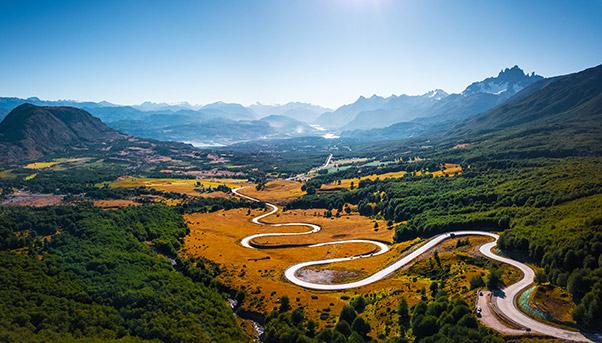
The journey starts from Puerto Montt. This port city named after President Manuel Montt at the foot of the Osorno volcano in the Los Lagos region is the jumping off point to the sort of unique experience that only a road trip can provide. This city built on the Pacific Coast, connected by a railway to the capital Santiago, is considered the gateway to Patagonia. From here the route along the Ruta de los Parques begins: 2,800 uninterrupted kilometers crossing 17 national parks reaching Cape Horn to form what has been called the most spectacular road in the world. This itinerary was planned with a view to transform a stunning natural heritage into a magnet for sustainable tourism that will support the country’s economic growth.
Riding to the end of the world
Inaugurated at the end of 2018, the Ruta de los Parques connects the Carretera Austral of Chile with the Ruta del Fin del Mundo, the famous “end of the world” road that leads to Cape Horn. Initiated by a project at the Tompkins Conservation charity foundation, the project to connect the region with a single road was carried out by the Chilean government, which contributed 10,000 square kilometers in land for new parks and redeveloped a further 18,000 square kilometers of existing parks.
According to the road’s official website, the finished route connects 17 national parks with an area of 113,000 square kilometers that represent 91% of Chilean nature reserves.
The journey from north to south crosses three regions (Los Lagos, Aysén and Magallanes), passes through 60 local communities, and through the habitats of 140 species of birds, 46 species of terrestrial and marine animals, and 24 ecosystems. The project was conceived not only to protect the environment, but also to transform this region into a worldwide attraction for sustainable tourism, thus encouraging the area’s economic growth, but also attracting research centers and international scientific laboratories that have an interest in investing in a protected place. This was the dream of Tompkins Conservation and its founder Douglas Tompkins.
A global magnet for sustainable tourism
The idea of creating a single road linking all of southern Chile, combining the natural wealth of this region in a single route, was the brainchild of US billionaire Douglas Thompkins and his wife Kristine, the owners of the world famous North Face brand who later who founded Tompkins Conservation. Thompkins has always loved Chile, and died there in a kayaking accident in 2015. The idea to link the region with a road was born from the desire – shared by the Chilean government – to exploit the huge naturalistic potential of the country in a sustainable way. The result was an itinerary, part road and part railroad, that links Chile’s national parks and tranforms the region into a magnet for sustainable tourism.
The agreement, defined by Thompkins Conservation itself as “the largest land donation in history by a private individual to a state” was signed in March 2017 and started the process for the preparatory work for the union of the parks and the realization of the itinerary.
«We want Chile to be internationally recognized for the most spectacular scenic route in the world, and thus become a benchmark for economic development based on conservation», said Carolina Morgado, executive director at Tompkins, in a press release.

Chile combines economic growth and protecting the environment
Although it came from the idea of a private foundation, Chile’s road to Patagonia is an example of this nation’s ever-increasing commitment to protect nature and to design sustainable development, which is reflected in its strategic preference for clean energy.
In the last five years – according to the book “Energy Revolution in Chile,” written by the former Minister of Energy, Maximo Pacheco — the country has tripled the share of clean energy of its total production, rising from 5% in 2014 to 18% at the end of 2018. This result was achieved thanks to investments aimed at the construction of large hydroelectric plants, but also to other sustainable energy forms, such as wind and solar.
This new development model is supported by the government, which aims to reach a 20% share of clean energy by 2020.
The longest routes in the world
La Ruta de los Parques is the latest member of a club that includes other spectacular routes that cross entire regions. Some of these are ultra-modern high tech arteries, such as Norway’s fjord highway, which is now undergoing an ambitious modernization project involving the construction of bridges and underground tunnels. Others resemble dirt roads, not easy to access, but still spectacular for anyone who decides to travel them.
The club of long and spectacular roads is led by the Great Trail of Canada, 23,000 kilometers that includes nature trails, waterways and actual roads; the Appalachian National Scenic Trail in the United States, which runs for 3,500 kilometers across 14 US states, from Georgia to Maine; Te Araroa in New Zealand, which travels from Cape Reinga to Bluff, covering a distance of 3,000 kilometers; and finally the 1,700 breathless kilometers of the Great Himalaya Trail, which crosses the legendary mountain range in Nepal.
These roads are the most extreme examples of a nature trek, where infrastructure disappears in many cases, leaving the road to simply follow the human heart’s desire for adventure.

